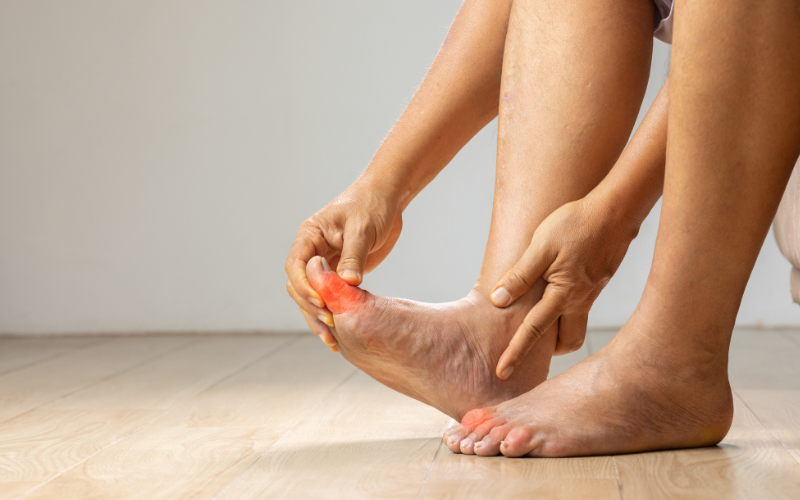Gout and arthritis are two commonly misunderstood conditions that affect the joints, often causing pain, swelling, and discomfort. While both conditions share similar symptoms, they have distinct causes and treatments. In this article, we will explore the differences between gout and arthritis, how to identify their symptoms, and the best ways to manage and prevent both conditions. Whether you’re seeking more clarity about your diagnosis or looking to better understand these conditions, this comprehensive guide will provide valuable insights.
What Is Gout?

Gout is a form of inflammatory arthritis that occurs when uric acid crystals build up in the joints. This condition often affects the big toe but can also affect other joints like the knees, ankles, and elbows. The accumulation of uric acid can result from various factors, including poor diet, obesity, dehydration, and underlying kidney problems.
Symptoms of Gout:
- Intense Joint Pain: The pain is typically sudden and severe, often waking individuals up in the middle of the night.
- Swelling and Redness: The affected joint becomes swollen, tender, and red.
- Warmth Around the Joint: The joint may feel warm to the touch.
- Limited Range of Motion: As the inflammation increases, movement becomes more difficult.
Gout flares can last anywhere from a few days to a couple of weeks, and without proper treatment, it can lead to more frequent attacks and long-term joint damage.
What Is Arthritis?
Arthritis refers to a broad range of conditions that affect the joints, causing inflammation, pain, and stiffness. The most common types of arthritis are osteoarthritis and rheumatoid arthritis, but there are several others as well. Unlike gout, which is often related to uric acid buildup, arthritis can occur due to various causes, such as cartilage degeneration, autoimmune diseases, or infections.
Symptoms of Arthritis:
- Chronic Joint Pain: Unlike the sudden pain associated with gout, arthritis often leads to a gradual onset of pain that worsens over time.
- Stiffness and Swelling: Joint stiffness, especially in the morning, is common with arthritis, and swelling can occur in the affected joints.
- Reduced Range of Motion: As the disease progresses, the joints may become less flexible, making it difficult to perform certain tasks.
- Fatigue and Fever: In the case of rheumatoid arthritis, systemic symptoms like fatigue and fever may also appear.
Key Differences Between Gout and Arthritis
Although both gout and arthritis affect the joints, the conditions have unique features that help differentiate them. Below are the primary differences:
- Cause:
- Gout: Gout is caused by an accumulation of uric acid in the bloodstream, which then forms crystals in the joints. Factors such as a high-protein diet, excessive alcohol consumption, and dehydration contribute to the risk of developing gout.
- Arthritis: Arthritis, especially osteoarthritis, is often due to the gradual wear and tear of the cartilage in the joints. Rheumatoid arthritis, on the other hand, is an autoimmune condition where the body’s immune system attacks its own joints.
- Onset of Symptoms:
- Gout: Gout attacks are sudden and intense, often starting with severe pain in the big toe or another joint.
- Arthritis: Arthritis symptoms typically develop gradually over time, with pain and stiffness becoming more noticeable as the disease progresses.
- Affected Joints:
- Gout: Gout typically affects the big toe first but can also involve other joints like the knees, ankles, and elbows.
- Arthritis: Osteoarthritis commonly affects weight-bearing joints, such as the knees, hips, and spine. Rheumatoid arthritis usually impacts smaller joints like the wrists, hands, and feet.
- Duration of Symptoms:
- Gout: Gout flares can last from a few days to a few weeks, with periods of remission in between.
- Arthritis: Arthritis is a long-term condition that persists and gradually worsens over time without appropriate management.
- Treatment:
- Gout: Gout treatment involves medications that reduce uric acid levels and manage pain and inflammation. Lifestyle changes, such as avoiding purine-rich foods and alcohol, are also important.
- Arthritis: Arthritis treatment focuses on reducing inflammation, managing pain, and improving joint function. This can involve medications, physical therapy, and in some cases, surgery.
How to Diagnose Gout vs. Arthritis
The diagnosis of gout or arthritis involves a combination of physical exams, medical history review, and diagnostic tests.

- Physical Examination: A doctor will assess the joint for signs of swelling, redness, warmth, and limited range of motion. Gout often presents with an extremely painful and inflamed joint, while arthritis tends to show gradual symptoms over time.
- Blood Tests: A blood test measuring uric acid levels can confirm the presence of gout. For arthritis, blood tests may reveal markers of inflammation or autoimmune activity.
- X-Rays and Ultrasound: Imaging techniques can help evaluate joint damage. X-rays are used to assess cartilage wear in arthritis, while ultrasound can detect uric acid crystals in gout.
- Joint Fluid Analysis: In some cases, a doctor may take a sample of fluid from the affected joint to look for uric acid crystals or signs of infection, which can help confirm a diagnosis of gout or arthritis.
Managing Gout vs. Arthritis
While both gout and arthritis require medical attention, there are different management strategies for each.
Managing Gout:
- Medications: Nonsteroidal anti-inflammatory drugs (NSAIDs) and colchicine are commonly used to manage acute gout attacks. Long-term management may involve medications like allopurinol to lower uric acid levels.
- Diet and Lifestyle: Reducing alcohol intake, avoiding high-purine foods (such as red meat and shellfish), and staying hydrated are essential for preventing gout flares.
- Weight Management: Maintaining a healthy weight can reduce the risk of gout attacks and relieve joint stress.
Managing Arthritis:
- Pain Relievers: NSAIDs and corticosteroids can help manage pain and inflammation associated with arthritis.
- Physical Therapy: Physical therapy is often recommended to improve joint function, strengthen muscles around the affected joints, and reduce pain.
- Surgery: In severe cases of arthritis, surgery such as joint replacement may be necessary to restore function and alleviate pain.
Conclusion
Gout and arthritis both affect the joints and cause similar symptoms, but understanding the differences between these conditions is crucial for proper diagnosis and treatment. Gout is caused by uric acid crystal buildup, while arthritis includes a wide range of conditions with various causes, including cartilage wear and autoimmune diseases. With proper medical care, lifestyle changes, and preventive measures, both gout and arthritis can be managed effectively, helping you lead a more comfortable and active life. If you’re experiencing joint pain, it’s essential to consult a healthcare professional for an accurate diagnosis and appropriate treatment.

Leave a Reply